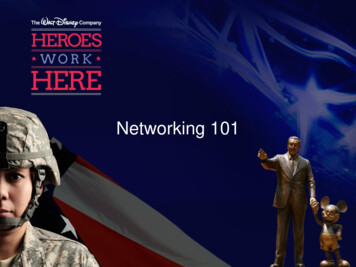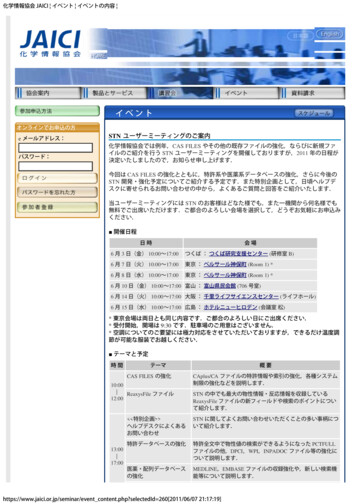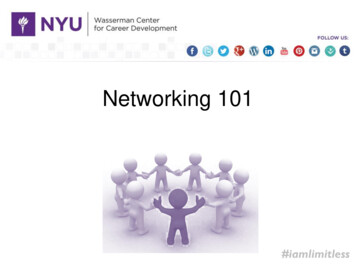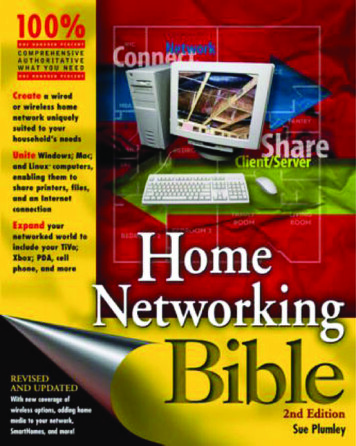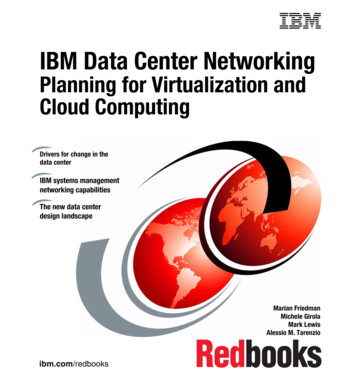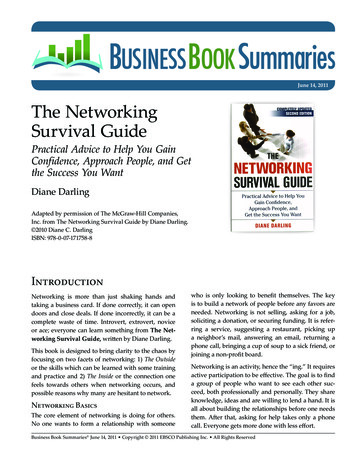
Transcription
June 14, 2011The NetworkingSurvival GuidePractical Advice to Help You GainConfidence, Approach People, and Getthe Success You WantDiane DarlingAdapted by permission of The McGraw-Hill Companies,Inc. from The Networking Survival Guide by Diane Darling. 2010 Diane C. DarlingISBN: 978-0-07-171758-8IntroductionNetworking is more than just shaking hands andtaking a business card. If done correctly, it can opendoors and close deals. If done incorrectly, it can be acomplete waste of time. Introvert, extrovert, noviceor ace; everyone can learn something from The Networking Survival Guide, written by Diane Darling.This book is designed to bring clarity to the chaos byfocusing on two facets of networking: 1) The Outsideor the skills which can be learned with some trainingand practice and 2) The Inside or the connection onefeels towards others when networking occurs, andpossible reasons why many are hesitant to network.Networking BasicsThe core element of networking is doing for others.No one wants to form a relationship with someonewho is only looking to benefit themselves. The keyis to build a network of people before any favors areneeded. Networking is not selling, asking for a job,soliciting a donation, or securing funding. It is referring a service, suggesting a restaurant, picking upa neighbor’s mail, answering an email, returning aphone call, bringing a cup of soup to a sick friend, orjoining a non-profit board.Networking is an activity, hence the “ing.” It requiresactive participation to be effective. The goal is to finda group of people who want to see each other succeed, both professionally and personally. They shareknowledge, ideas and are willing to lend a hand. It isall about building the relationships before one needsthem. After that, asking for help takes only a phonecall. Everyone gets more done with less effort.Business Book Summaries June 14, 2011 Copyright 2011 EBSCO Publishing Inc. All Rights Reserved
The Networking Survival GuideMarketing, Networking, and Selling are interdependent upon each other; without the other two, one isless productive. Marketing educates the target market and createsawareness. Networking connects people who can solve problems for each other. Selling fills a need.This powerful trio works when all the pieces areplayed in order. It may be tempting to skip a step ortwo to get directly to the desired end result, the sale.This leads to one feeling like they are being sold. It ismuch easier when the target market is already awareof the services being offered and has received a referral from a trusted source. By the time the client gets tothe buy stage, the due diligence period is over and thedecision is made. No hard selling required.Networking is often confused with schmoozing.Schmoozers are superficial and are only looking forhow quickly they can benefit. Typically they are onlyheard from when they need something. Networkingis relationship based and is mutually beneficial. Whileit need not be constant, when the need arises the connection is there.Time is precious and tough decisions are required.Make time for those: who make time for you who leave you feeling positive, energized andworthy who offer value from whom you can derive benefitsSend anyone who falls outside these areas to theacquaintance network. While they are not completelybrushed-off, they do not deserve the time and energyrequired for those within the true network.Preparing to NetworkThe key to building a relationship is to give firstbefore seeking to receive. The first step in preparing to network is to engage in casual conversationwith complete strangers. The book provides severalexercises to help the reader practice being friendly.One suggestion is to make eye contact and smile at aminimum of two unfamiliar people each day. ThereDiane DarlingKey ConceptsThe Networking Survival Guide by Diane Darling is a book that takes the mystery out of howto network successfully: Networking is not about what you get outof it. The key to obtaining optimal results isto first find out how you can help the otherperson. Focus on building the relationshipfirst before you look to benefit yourself. Networking is a learned skill. While manymay intuitively know how to network, tobe truly effective you must receive propertraining. Practice makes perfect. Be prepared to network. Do your researchand pack your survival bag. These smallsteps build confidence, fuel conversation,and save time. Look for introductions. Grow and maintainyour network by introducing people whoare a natural fit. Ask for an introduction toreduce awkwardness of meeting someonenew. Network everywhere. Networking happensat work, in a shared taxi cab it can happenanywhere. Always carry your business cardsand take advantage when an opportunitypresents itself.g g g gInformation about the author and uthorInformation about this book and other business titles:www.mhprofessional.comRelated summaries in the BBS Library:The ConnectorsMaribeth KuzmeskiMake Your Contacts CountAnne Baber and Lynne WaymonBusiness Book Summaries June 14, 2011 Copyright 2011 EBSCO Publishing Inc. All Rights ReservedPage 2
The Networking Survival Guideare follow up questions and suggestions to allow oneto further explore the results of the exercise and gainimprovement.Diane Darlingblogs, posts, links to useful articles, etc – must delivera grand first impression to clear the way for a deeperrelationship.Online networking makes some of those exercisesTo inventory your network, go through your contactseasier. The author suggests Meetup.com and Yahooto find ways in which to connect people, unknown togroups, but cautions to attend the first group activeach other, within that network. Send both an emaility at a public venue and/or bring a friend for safetyexplaining how they connect (hobby, job, education,reasons. She ends with a brief description of the threeetc) and provide a way for them to meet each other.major online networking tools (LinkedIn, FacebookMaking the effort establishes yourself as a valuableand Twitter). Regardless of the networking avenue“go-to” person to solve problems.chosen, one must have a plan with goals which areclear, flexible and SMART (SpeWhen you have identified and organized your networks, it’scific, Measurable, Achievable,easier to find the right person for the right problem.Realistic, and Timed).Whatever the main networkinggoal, (raising capital, business or professional development, etc.) the networker must be open to changein case things are not what they expected. Map out thejourney beforehand to save time, energy, and money.Determine the type of people you want added toyour networks. While everyone wants to have thousands of contacts, focus on quality not quantity. Anonline network typically does not hold the power atraditional network does, unless you provide highlyregarded content or services. Any content produced –About the AuthorDiane Darling considers herself a friendly,functional introvert. While she is adept at beingat a cocktail party, she does not look forward toit. She developed her skills as a child by livingin several countries and by just being curious.She prefers to network through writing, being aspeaker and by connecting with people.Most recently she was the keynote speaker atMIT Charm School. She has worked with a variety of corporations, nonprofits, universities andgovernment agencies. She has been featured onNBC Nightly News, in the Wall Street Journal,Washington Post, San Francisco Chronicle, International Herald Tribune just to name a few. She isbased in Boston, MA.While there is value in cross-networking, take careand be sensitive to not match anyone with strong,opposing political or religious views.Next, evaluate each contact within the network. Is thisperson key to achieving one’s goal? Do they returnphone calls within 48 hours? Being in a network is nota popularity contest. It is about building a group ofpeople who can be counted upon and vice versa.Next, evaluate every company you are affiliated with.Did the company help earn new clients, refer someoneto fill a vacant position, introduce a new supplier? Isthere a key individual inside the company or organization? Are other relationships in place if that personwas to leave? When evaluating organizations youvolunteer with, evaluate your role within the group.What value does being a member bring? How muchtime does it take? Does being involved evoke energyor dread?To focus on evaluating the people within those companies and organizations, ask three questions:1. Will they will call back within a week.2. What can the networker offer that person?3. What can that person offer the networker?The next step is to rank clients based on revenue orprofitability. Create a business profile for the top andbottom 5%. From the bottom five percent, list thosebusinesses that have people you genuinely like. Dothe same with the top five percent. Evaluate why theyBusiness Book Summaries June 14, 2011 Copyright 2011 EBSCO Publishing Inc. All Rights ReservedPage 3
The Networking Survival GuideDiane Darlingare likable, how to make them more successful, andwho they can be introduced to.five percent. The goal is practice, and one should notbe practicing on top clients.Contact Strategy TemplatePay attention to the little things: appropriate attire, aproper handshake, good manners and saying thankyou. Taking care of the little things keeps the focuson the big things. Consider using the following tohelp make a winning first impression: Wardrobe/Image Consultant, Hair Stylist, Dining EtiquetteClasses, Manners Coach, Personal Trainer, Presentation Coach, Acting Class, Business Writing, Dentist,and Networking Coach.1. Prepare – create a bullet outline including why theperson is being contacted and what one wants inreturn. For example: Calling Jack Jones Want introduction for Ms. Smith @ Smith andAssoc.Networking gives you ways to stay in touch and helps youdiscover who those people in your life are. This is not a popularity contest like high school. This is not just about people welike; it’s more than that. It’s about people we can get help fromwhen we need it and vice versa. Would like to provide legal services Expertise in mergers can help her grow thecompany2. Email and call for a meeting – doing both feelsmore personal.3. Let them know why they are being contacted.4. Set the meeting at a time that is best for them.5. Pick up the tab for any expenses.6. At the meeting, do the following: Be very specific. Create an atmosphere in which they can sayno. Tell them what is in it for them.7. Afterwards:Take classes to build on businessskills and better manage one’scareer path: Management Training, Leadership, Sales Coach,Hiring and Firing Skills, ConflictResolution and Stress Management, Meeting Management, Timeand Project Management, Right Brain or Left BrainBuilding Activities (if one is more analytical, take anart class etc), and Communications. You might alsoconsider hiring a Career Coach.Build a Personal Board of Advisors, a team of five orsix people, who are liked, known, and trusted. Politician or Mentor – Someone who has an interestand desire to see one succeed and has the time tohelp. Strategist – sees what is needed to realize the future and creates a map to get there. Problem Solver – Has experience in overcomingchallenges and can offer techniques for moving onto the next step. Coach – can help determine what is holding oneback. Send an email or paper thank you within 48hours. Butt Kicker – Holds one accountable and challenges negative thinking. Keep the person updated on progress. Cheerleader – A positive person with a glass halffull perspective. Ask what can be done for them.8. Repeat above steps for each contact.To make the best use of time, prioritize those contactsthat you have the most in common with. Reorganizerather than eliminate the remaining contacts. Whenpracticing networking skills, stay away from the topDiscuss expectations and “term limits” clearly. Identify specific goals and ways this person can help.Create a Peer Group with other professionals in comparable positions in other companies. Keep it limitedto about 12 people. This group can become invaluableBusiness Book Summaries June 14, 2011 Copyright 2011 EBSCO Publishing Inc. All Rights ReservedPage 4
The Networking Survival Guideas it allows discussion of matters that cannot be discussed with the Personal Board of Advisors.Diane DarlingNetworking TechniquesIn order to be successful at networking, you musthave the appropriate tools. Top on this list is the business card—always carry them, but make sure thecards leave the right impression. A good card is freeof errors, contains an email address and a telephonenumber, has plenty of white space, is on 80-poundstrength and 14-point thickness, and uses a minimum10 point font. Refrain from using folded cards and ifthe backside has print, leave some room for notes.Find a Networking Buddy. This person is not a competitor, but offers services to a similar target market.Choose someone who enjoys networking during thesame time of day and can be completely trusted.The value of this buddy is dependent upon the timeinvested in the relationship. In shared professional circles, each party represents the other. They can arriveat events together, make introductions, and then splitup. After a while, assess the value ofcontinuing and leave if the event is not Respect your cards and put themworthwhile.image when you are not around.Creating a “Whether Report” is a wayto determine whether or not one should attend anevent, contact someone, or join an organization. A basiconline search to find reviews is a good place to start.Review contacts and see if anyone is familiar with anorganization or event and get their feedback. SearchLinkedIn and Facebook to see if anyone of interest isa member of the organization or shares similar interests. Investigate the host organization, the attendees,the speaker, the sponsors, the industry, the logistics(day, time, price, parking, etc), the weather, who wasthe invitee, and what the ultimate goal would be.After reviewing all these separately, you can clearlyjudge if the event is worth your time. This whetherreport can be readjusted to analyze membership in aspecific organization or if a particular contact is worthpursuing. The book offers a thorough breakdownof each report and provides numerous examples foradded clarification.After completing the whether report, an additionalstep is necessary—qualify the networking event.Time is valuable and if one must be away from theoffice or the family, the event needs to be worthwhile.Ask yourself what the main reason is for going. Theanswer should fall into one of three reasons:1. Connecting with colleagues2. Business opportunities3. Personal growthBy taking the time to prequalify an event, it is morelikely to be a successful experience.in a case. They are yourWhen to hand out a card: At meetings: In the beginning before it starts. Networking event: After the conversation is over. Ask for a card and mention intentions to followup, while observing body language. Give a card when asked and never walk up topeople and start handing out cards. Give only one card, any additional usually getthrown away.The leave behind card is given in addition to the business card. It is a card full of fun facts or interestinginformation about you or your business. It usuallystarts a conversation and leaves an impression.Use two card cases: one to carry your card and one tocarry the cards you receive. Keep an adequate supplyof cards on hand at all times.After the event, it is time to process the cards and storethem. When you are initially given the card, look at itand try to make a connection between the card andthe person. Make notes on the card of anything promised. Be sure to follow up within five to seven dayswith any promised item. Determine which cards tokeep and who to follow up on. Store the cards eitherelectronically or in a manual filing system.Other networking accessories include a notepad andpen, a functional briefcase, and an ability to silenceany electronic item carried.Body language, voice, tone and pitch account for 93percent of communication. This is why misunder-Business Book Summaries June 14, 2011 Copyright 2011 EBSCO Publishing Inc. All Rights ReservedPage 5
The Networking Survival GuideDiane Darlingstandings are more common in the age of text andemail. To give the best impression using body language, maintain 18 inches of personal space, do notslouch, keep your shoulders and hips parallel, smile,maintain eye contact, and keep your hands out ofpockets.To continually fill your networking repertoire, spend15 minutes reading the newspaper every day. Quicklyskim the headlines and watch the local and nationalnews channels. Read three popular magazine covers:news (Time or Newsweek), business (BusinessWeek,Fortune or Forbes), and general interest (People). Beaware of what is happening in theattention first inbusiness world.In business, it is essential to get someone’sorder to continue and potentially do business together. Howyou are perceived in a discussion affects how you will bejudged professionally.Practice saying your name like a statement. Injectenergy and enthusiasm into your everyday voice. Trysmiling and consider standing up before answeringthe phone. Take control of the conversation by eitherslowing down or picking up the pace. Consult yourNetworking Buddy to ensure that you are not mumbling or talking too softly.Use a vocabulary level appropriate for the audience.Avoid acronyms and industry jargon unless you arespeaking to people who also use them. Avoid alienating your listeners by using sports analogies, slang,vulgarity, or clichés. Speak in complete sentences anduse proper grammar. For immediate feedback, videotape and evaluate yourself speak.Being able to engage in a pleasant conversationstrengthens self-confidence and makes you memorable. Completing the research discussed earlier makesa difference in creating good conversation. Knowingahead of time any mutual acquaintances or sharedinterests can fill the void after the initial introductionsare made. It is also useful to memorize three neutralquestions: “Tell me how you know the host, company, organization, etc?” “What made you decide to come?” “What other organizations do you belong to?”Become familiar with some neutral topics to helpfuel the conversation, such as the local sports team,the business you are in, movies, books, and sports. Beobservant of what is going on around you. Are thereany special attractions, a park, or something similarin the area?Conversations are best startedwith a smile and an outstretchedhand. Keep the conversationsimple and neutral. Your purposeis to make the other person feel important. If you arenervous, you are thinking too much about yourself.Practice good listening skills by making eye contactand facing the person. Avoid talking negatively aboutanything or anyone, and attempt to redirect any conversation which brings up religion or politics. Limitthe conversation to three to five minutes and leavebefore being left.There are many other opportunities for networkingother than specific events. Take 15 minutes each weekand invite a different co-worker to coffee. Planes andtrains are common areas, but respect fellow travelers. Pay attention to body language or any other signsthey wish to be left alone.Before attending any conference or tradeshow, doyour research first. Learn who the speakers are, whatvendors are going to be there, and where they arelocated. Book a table for 20 at a local restaurant andinvite new acquaintances to dinner. To avoid payingfor everyone, mention the price of the average item onthe menu. Let the server know in advance everyoneis paying individually, but be prepared to tip well forthat service.Job fairs and meetings are also great networkingopportunities. Again, it is important to do someresearch first to find out who is attending. Have penand paper to take notes and come prepared with business cards.A good introduction is brief (5 to 10 seconds) andinvites conversation. It should include three things:1. How you fit into the situation.2. Your nameBusiness Book Summaries June 14, 2011 Copyright 2011 EBSCO Publishing Inc. All Rights ReservedPage 6
The Networking Survival Guide3. Why the other person should careExample: “I am an exhibitor at this show from PeopleTechnology, my name is Susan Smith, and we helpcompanies find the right people for their technologypositions.”Practice until it becomes automatic. You want yourintroduction to create a response. If it shuts down theconversation, it needs more work.Be polite and have manners at all times. While it maynot be directly commented upon, it is noticed andappreciated. Continually practice until you are ableto teach someone else. It increases your confidence toknow how to act in every circumstance.Networking SurvivalIt is important to wear clothes that make you feel confident and helps others to easily describe you. Menshould wear a tie with a complimentary design andwomen should wear a suit in a color other than navy,brown or black.Diane Darlingup and down slightly, hold for a moment and then letgo. Maintain eye contact throughout the handshakeand the introduction. As a sign of confidence andequality in the business world, ladies should extendtheir hands first.At the event, focus on the event, not the food. Avoidcarrying beverages and hors d’oeuvres. Considersnacking before arriving at the event to avoid beinghungry. When carrying a glass, do so in your left handto avoid a clammy handshake. Limit alcohol drinks totwo and drink water in between. Never drink from acan.Make it your goal to meet people who you can addvalue to, and vice versa. If you are looking to meet thespeaker or a VIP attending, do so before the presentation. If you are looking to meet someone else, findsomeone who can make an introduction. In conversation, remember to ask what you can do for people, itbuilds rapport.Afterwards, do not forget to follow up. When othersfollow up, return their call even if the answers to theirquestions are not available. Be a professional whotreats everyone with respect.Always carry the Networking Survival Kit with you.It contains business cards, two business card cases,pen, 3 x 5 note cards, sharpie marker (for your namebadge), breath mints, directionsto the event, printout of the front You want people to remember you, not your handshake. Yourpage of the hosting organization’s handshake is one of the most important communication toolswebsite, and the staff and boardyou have. Use it to your advantage.members of the organization. Iffor a meeting, add a portfolio forHow you follow up depends on the urgency involved.taking notes.If you find yourself moving quickly into sales mode,consider sending an express package with contractsFor the office and/or the car, have a small survival kitor an email with pertinent information. If followingfilled with toiletries. Some necessary items includeup from networking (to say thank you or to stay intoothbrush and paste, hand lotion, nail file andtouch), ask the person when taking their card howclippers, comb and/or brush, hair spray, lint roller,they prefer to be contacted. Use voicemail when theshaving kit or cosmetics, tissues, moist towelettes,tone of voice is important to smooth over a misundermints, safety pins, and a sewing kit.standing or express energy and excitement. You canPlace your name badge high on your right shoulder.never go wrong with regular mail. Dropping a note inWrite your name using a sharpie for easier reading. Ifthe mail can help you stand out from the masses andgutsy, add something memorable. An example: “Dan,sends the message that you are thoughtful.the Dr. Phil of Business Banking.”When extending an invitation to lunch, be clear aboutIt is important for both men and women to have a firmyour intentions and pick up the bill. It is sometimesand confident handshake. The webbing in between theeasier, and cheaper, to bring coffee to their office andthumb and first finger of each person should touch.chat. Whichever situation, be flexible and open toThe palms should touch lightly, avoid cupping. Shakerejection. If someone feels comfortable saying no, theyBusiness Book Summaries June 14, 2011 Copyright 2011 EBSCO Publishing Inc. All Rights ReservedPage 7
The Networking Survival Guidewill respect you and remember you in the future.If someone that you have been introduced to is notreturning your phone calls, keep the person whomade the introduction in the loop. Ask their advicefor next steps and keep that person updated. Introduced or not, discontinue contacting them after threeattempts.Diane Darlinggroups, volunteering opportunities, writing andspeaking opportunities, serving on a corporate ornon-profit board, and cause-related marketing campaigns.Be ethical in all of your networking dealings. Use onlythe names of people who have given you permissionto do so. When in doubt, underplay your connection.Do not mislead anyone regarding“Coffee dates” involve less of a time commitment and are seenendorsements. If an endorsementas less intrusive than a lunch meeting. Plus there’s less risk of is necessary, get an email or letterof introduction from that person.having a conversation with a valuable contact with a sesameAvoid overstating the depth ofseed stuck in your teeth!your relationship.Online networking is growing in popularity and thereare three major sites: LinkedIn, Facebook and Twitter.There are three keys to effectively using these onlinenetworking services: Research (people and companies), Personal Branding (how you want others to seeyou) and Networking.Online participation varies greatly depending uponage and experience. The younger the person, themore likely they are to have a strong online presence. Regardless, everyone should be familiar withthe different online communities or risk missing outon some valuable opportunities. Whichever onlinevenue used, be professional at all times.When sending email, make your name visible to thereceiver (this is done through email software). Thesubject line is like the headline of a newspaper article—it gives the receiver a reason to open your emailand read it. Use “cc” only if everyone receiving theemail knows each other, otherwise use “bcc.” Whenreplying back and forth, change the subject line toreflect new topics. Create a signature to appear atthe bottom of every email. Always use proper grammar and if there is a risk of misinterpretation, make aphone appointment instead.To become more visible to peers, colleagues, competitors, vendors, etc., it is crucial to become activelyinvolved in a professional association for careeradvancement. Consider attending a new organizationor meeting once per month to find a group that fitsyou and your goals best.Other ways to grow your network include alumniSometimes we do not feel like networking. At thesetimes it is important to ask yourself why. It may bebecause you are tired, have worked too many hours,or the location is not convenient. In those moments itis a good idea to examine the value in attending. Avoidnot attending for fear-based reasons (concerned aboutnot knowing anyone, not fitting in, etc). Doing so canerode your confidence and only perpetuates the problem.When going is necessary and you are struggling,there are some things you can do to get yourselfexcited. Attend the event with a buddy, arrive a littlebit early, focus on thinking about what you can do forothers, practice a couple of jokes, and wear somethingthat makes you feel great. Since networking does notimmediately produce value, it is easy to avoid going.In the case of nervousness,, here are two exercises toperform for relaxation. Start by out stretching yourlegs, closing your eyes and tensing up your upperbody for 10 seconds. Relax and take a deep breath.Repeat tensing up and turn your head to either sideand pull it down gently. Deep breath again, tense upand this time point your toes forward. Relax.For the next exercise, sit up straight, close your eyesand place your hands at your sides. Take a deep breathfor a count of four, hold for four seconds, and exhaleslowly for four seconds. Do this three times.The key to networking is practice. Be patient withyourself as you begin to network. Over time you willperfect your skills and you will have met many newand fascinating people in the process. Focus on justBusiness Book Summaries June 14, 2011 Copyright 2011 EBSCO Publishing Inc. All Rights ReservedPage 8
The Networking Survival Guidesaying hello and asking what you can do for thatperson. Happy Networking!g g g gFeatures of the BookReading Time: 4-6 hours, 249 pagesThe Networking Survival Guide is a book that takesthe mystery out of how to network successfully. Itcontains many examples and best practices for everyone from the employee seeking to get ahead to thebusiness owner looking for new clients. In additionto the clear and practical advice, there are diagrams,examples, exercises and personal stories. This book isdesigned to be read from front to back as there arereferences to earlier introduced material. It is likelyanyone who reads the book will keep it as a part oftheir reference library to be looked at again and again.Diane DarlingChapter 16: Gender, Race, Culture and Other Networking FactorsChapter 17: Evil NetworksChapter 18: ntsIntroductionChapter 1: OverviewChapter 2: What Networking Is and What It Isn’tChapter 3: Getting StartedChapter 4: Preparing for NetworkingChapter 5: Networking AccessoriesChapter 6: Body Language, Voice, and WordsChapter 7: ConversationsChapter 8: Places to NetworkChapter 9: Best PracticesChapter 10: Best Practices When You Are Face-To-FaceChapter 11: Fo
Survival Guide Practical Advice to Help You Gain Confidence, Approach People, and Get the Success You Want Diane Darling Adapted by permission of The McGraw-Hill Companies, Inc. from The Networking Survival Guide by Diane Darling. 2010 Diane C. Darling ISBN: 978--07-171758-8 Introduction Networking is more than just shaking hands and



